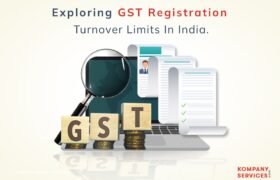E-commerce vendors are companies or individuals who sell items or services online using platforms such as Amazon, Flipkart, eBay, and others. Manufacturers, wholesalers, merchants, and even individuals wishing to offer their products or services online might be among these vendors. E-commerce vendors in India must follow Goods and Services Tax (GST) legislation and regulations.
GST Return Filing for E-commerce Business
E-commerce operators are required to file GSTR-8 returns every month within ten days after the end of the month. This return includes details of outward supplies of goods and services made by sellers through the platform and the amount of TCS collected.
E-commerce operators must also file an annual statement by December 31st, after the conclusion of the fiscal year in which the tax was collected.
Based on the declaration filed by the e-commerce operator, the amount of TCS paid to the government would be shown in the GSTR-2 of the real registered supplier.
The following details of e-commerce supplies, as disclosed in FORM GSTR-8, must be matched with the comparable details declared by the supplier in FORM GSTR-1:
- The supplier’s GSTIN.
- If the receiver is a registered individual, include their GSTIN or UIN.
- The location of the supply.
- GST The supplier’s invoice number.
- The invoice date from the supplier.
- The taxable value.
- The tax amount.
The GST registration process for e-commerce sellers is outlined here.
- Go to gst.gov.in and select Services>Registration>New Registration.
- The new registration form will appear; choose Taxpayer from the ‘I am a’ menu and provide further information such as location, legal name of the business, PAN, email ID, and cellphone number. Enter the captcha and press the ‘Proceed’ button.
- Verify the OTP through mobile and email, then hit the ‘Proceed’ button.
- This was the first step in the registration procedure.
- A Temporary Reference Number (TRN) will be assigned to you. Click the ‘Proceed’ button.
- Enter your TRN, captcha, and click the ‘Proceed’ button.
- Verify the OTP once again and click the ‘Proceed’ button.
- Your stored application will display with an expiration date of about 15 days; click on ‘Action’.
- You must now complete your profile on the site, which includes ten fields: Business Details, Promoter, Authorised Signatory, Authorised Representative, Principal Place of Business, Additional Places of Business, Goods and Services, State Specific Information, Aadhaar Authentication and Verification.
- Once all of the data have been entered, pick the approved signatory’s name from the ‘Name of approved Signatory’ drop-down list.
- Enter the location of the form in the Place field, for example, Delhi, Mumbai, etc.
Impact of GST Registration on E Commerce Businesses
The e-commerce business is dealing with a large and difficult challenge relating to tax collection at the point of sale. In India, e-commerce activities are subject to a variety of taxes, including VAT, CST, service tax, TDS, and others, which are frequently applicable within a single transaction. This results in a complicated compliance procedure and voluminous reporting.
The addition of logistics, reverse logistics, promotional services, and items such as music, eBooks, and software confuses the distinction between commodities and services in each transaction. Statutory forms and electronic waybills add another degree of complication, especially in interstate transactions.
Marketplaces are required to register and report their sales to several state tax offices. India’s GST regulations aim to establish a single marketplace by simplifying operations and lowering compliance expenses. However, limiting the cross-utilization of central taxes against state taxes may result in price rises as the tax burden is shifted to the end product.
Many features of e-commerce transactions are not regulated under tax law, including gift certificates, advance receipts, cash on delivery (COD), drop shipments, and other concerns. GST has made interstate sales more comparable to local sales, prompting a rethinking of warehousing techniques that promote customer proximity above tax concerns.
The transition from a 12.5% excise tax to a 17-18% GST rate can dramatically increase expenditures for e-commerce enterprises that purchase and store inventory. Furthermore, businesses may face taxation on unsold merchandise housed in warehouses, which would have a negative impact on their financial operations.
Benefits of E-Commerce Businesses in India
- E-commerce has removed geographical restrictions, allowing enterprises to access a worldwide audience. Consumers may now access a wide range of products and services from the comfort of their own homes, overcoming physical constraints.
- E-commerce provides unrivaled ease and accessibility 24 hours a day, seven days a week. Shoppers may explore, compare, and buy items or services at any time, which is extremely handy for today’s time-pressed consumer.
- The e-commerce ecosystem houses a varied range of products and services, ranging from everyday necessities to specialized specialty items, providing customers with access to a vast variety that traditional brick-and-mortar retailers may not offer.
- E-commerce frequently results in cost savings for both firms and consumers. Online businesses may save money on overhead while consumers save money on travel fees and time.
- Advanced algorithms are used by online platforms to personalize the shopping experience for users, boosting consumer happiness and sales through personalised recommendations.
Growth of the E-commerce Industry
The growth of the e-commerce industry is nothing short of phenomenal, driven by several key factors:
Digital Transformation
Technological advancements, notably the spread of smartphones and greater internet access, have given customers the ability to purchase online. This change has been aided further by the seamless integration of online payment platforms and secure transaction procedures.
Consumer Preferences and Behavior
Changing consumer behavior is critical to the industry’s success. The modern customer craves convenience and time efficiency, which e-commerce simply gives. Furthermore, an increase in internet buying during the COVID-19 epidemic hastened this transformation.
E-commerce platforms have expanded their offers to encompass not just retail but also services, entertainment, and other activities. The increased variety of online products and services has drawn a larger audience.
Marketplaces and Aggregators
The introduction of e-commerce marketplaces and aggregators has streamlined the purchasing experience by providing customers with a one-stop destination to compare prices and items, resulting in healthy competition and innovation.
Global supply chains have grown more efficient, allowing items to travel effortlessly from manufacturers to customers all around the world. This effective logistics network has fueled the expansion of cross-border e-commerce.
Importance of GST Registration for E-commerce Businesses
GST registration holds immense importance for e-commerce businesses due to several key reasons:
- GST registration is a legal requirement in several countries, including India. E-commerce enterprises with a revenue of more than a certain amount are needed to register for GST. Noncompliance might result in significant fines and legal troubles.
- One of the most significant benefits of GST registration is the possibility to claim Input Tax Credit (ITC). This implies that e-commerce enterprises may deduct the GST paid on purchases from the GST received on sales, decreasing the overall tax bill and making the business more tax-efficient.
- GST registration lends credibility to an e-commerce firm by displaying a commitment to adhering to the legal framework and establishing trust in consumers and partners. improved credibility frequently leads to improved sales and business growth.
- GST registration is sometimes required for participation in online marketplaces and platforms, which opens the door to partnerships and selling on major e-commerce platforms, allowing your firm to increase its reach.
- Registered e-commerce enterprises must file frequent GST returns, supporting efficient financial and tax administration through precise transaction records.
Challenges for GST Registration in E Commerce
Registration
E-commerce sellers and providers must register under GST regardless of sales. This may be unfair to small eCommerce shops because offline vendors that sell less than 5 Lakhs for the North Eastern states and 10 lakhs for the rest of India are exempt.
Amazon and Flipkart employ the marketplace or drop shipping approach, storing products from sellers and sending them to customers after receiving orders. Sellers register these warehouses as extra places of business under local VAT, while e-commerce businesses do not. Both eCommerce firms and sellers must register these warehouses as primary and additional places of business under GST. These warehouses sometimes lack physical segregation between merchants’ goods, making this difficult.
Stock Transfer
If there is GST, the way that stock moves from the seller to the warehouse would be handled differently, since any “supply” is taxed. Since buyers don’t usually “sell” stock to e-commerce companies, this could cause taxes to rise across the board.
At the moment, some states don’t let marketplace stores be registered as extra places of business. This might be different under GST. Also, marketplaces will have to sign up in every state and region of the union.
Place of Supply
It’s easy to figure out where things come from, but where do services come from? This decision might be hard for e-commerce companies, especially big ones like Shoppers Stop that get their goods from more than one state.
Tax Deduction at Source (TDS)
The tax rules that are in place say that sellers on eCommerce platforms must take Tax at Source (TDS) out of the fee they pay the platform. They need to pay TDS, get Form 16, send it to the online store, and then get their money back. The whole process has changed because of GST. The market takes out its fee and TDS, and then it sends in a TDS return. The seller will instantly get a credit for the TDS that was taken out in his computer credit ledger. He can use this credit to pay off his tax debt. The effect is stronger when a customer returns an item and the TDS that was taken out has to be put back on.
Return Matching
This return matching process ensures that the tax liability is accurately calculated and assigned to the appropriate party. It also encourages sellers to report all their transactions correctly, as any discrepancies can result in penalties for the seller.
Solutions for GST Registration in E Commerce
If you own an e-commerce business in India, it can be hard to figure out how to register for GST and follow the rules. This is where we come in. Our team of dedicated professionals is here to help you with all of your GST registration needs, making sure the process goes smoothly and without any problems. We know how E-commerce works and what it needs, and we can help you with every step of this GST application process. Get in touch with us right away for professional help and dependable GST registration services, and start your trip to compliance, growth, and success in the Indian world of online shopping.
Image by Freepik




